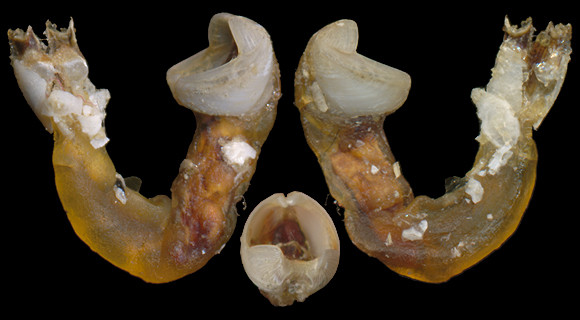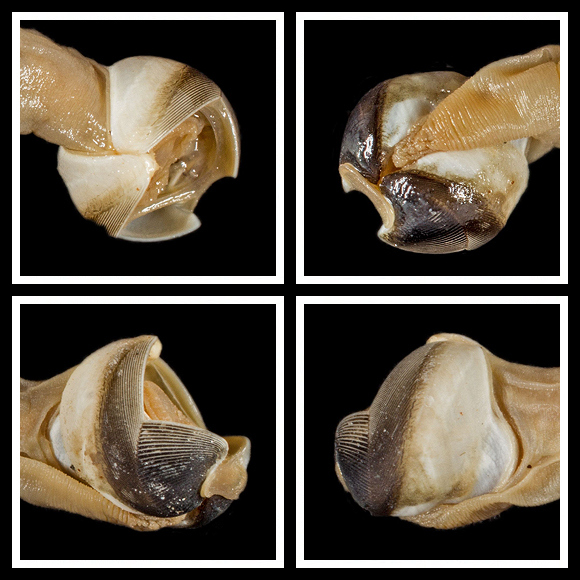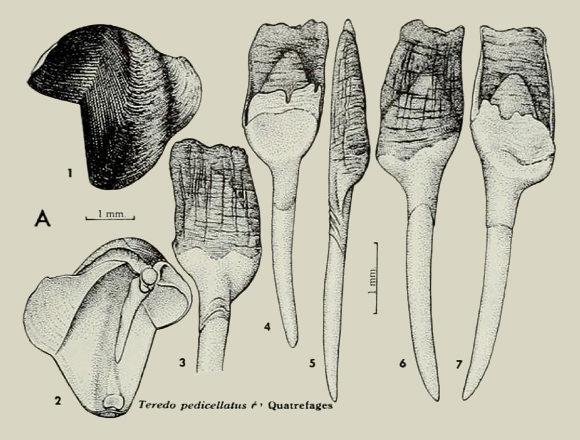
Original taxon: Teredo pedicellata.
Huge quantity of synonyms throughout the world, but: « Genetic analysis of Lyrodus pedicellatus in the northeast Atlantic and Mediterranean Sea indicates that these two populations may represent two cryptic species (Borges et al., 2012). Further genetic analysis is needed to evaluate the possibility of cryptic species and cryptic invasions throughout the reported range of L. pedicellatus » (Cal-NEMO).
This specimen was found in wood, off Cesenatico, Forli Cesena, Emilia-Romagna, E. Italy. Lenght of the valves: 3mm. Nota bene that the only way to determine whether a Teredinid belongs to the genus Teredo or to Lyrodus is given by the observation of the terminal pellets. Also, Lyrodus used to host its eggs inside the valves.
This specimen was found in wood, off Cesenatico, Forli Cesena, Emilia-Romagna, E. Italy. Lenght of the valves: 3mm. Nota bene that the only way to determine whether a Teredinid belongs to the genus Teredo or to Lyrodus is given by the observation of the terminal pellets. Also, Lyrodus used to host its eggs inside the valves.

« Shell small, subglobular. white. The extreme anterior part with a strong sinus covered by a heavy callus, which is reflected over part of the outer portion as a thin callus, through which the dental ridges may be seen. These bend suddenly downward at the anterior margin, and then spread fan-shaped backward, being separated by spaces about three times as wide as the ridges. These ridges slope abruptly on the dorsal side and much more gently on the ventral, the ventral side being about twice as long as the dorsal. Of these ridges, which are finely denticulated at their free margin, 22 are present in the type. The anterior median area is quite narrow and marked by dental ridges bearing rather prominent tubercles. These dental ridges join those of the anterior part at almost a right angle. The middle median portion forms a depressed groove which is crossed by rough U-shaped curved wrinkles. » – P. Bartsch for Teredo townsendi in “A monograph of the American shipworms”, United States National Museum Bulletin vol. 122, Washington 1922, p.26. – Above: a specimen collected in the Puerto deportivo, San Sebastián, Gipuzkoa, Euskal Autonomia Erkidegoa, N. Spain. Original pictures provided by M. Caballer for the MNHN, Paris, France – (CC BY).

« The posterior portion is a little wider than the anterior and median portion combined, and is marked by a series of wavelike markings, between which finer lines of growth are present. The posterior part forms a conspicuous triangular auricle, which is rather large and not strongly separated, though somewhat constricted at its junction with the posterior median portion. The interior is bluish white. The junction of the anterior and median portions is marked by a raised thread. The median portion is a roughened groove at the basal termination of which the ventral knob is placed. The posterior part projects over the posterior median portion as a conspicuous shelf. The free auricular portion is marked by concentric lines of growth. The umbone has a strong knob, from the basal portion of which a narrow blade extends down through about half the length of the shell. Pallets paddle-shaped, rounded at the distal end, which is surmounted by two strong periostracal prongs, which form a forked tip. The distal half of the outside, which is rounded, is covered by a periostracum. The inside is slightly concave, the distal half also having a thin brown periostracum. » – Ibid. – Above, the species in R. D. Turner: A survey and illustrated catalogue of the Teredinidae (Mollusca: Bivalvia), Harvard 1966, plate I, A.